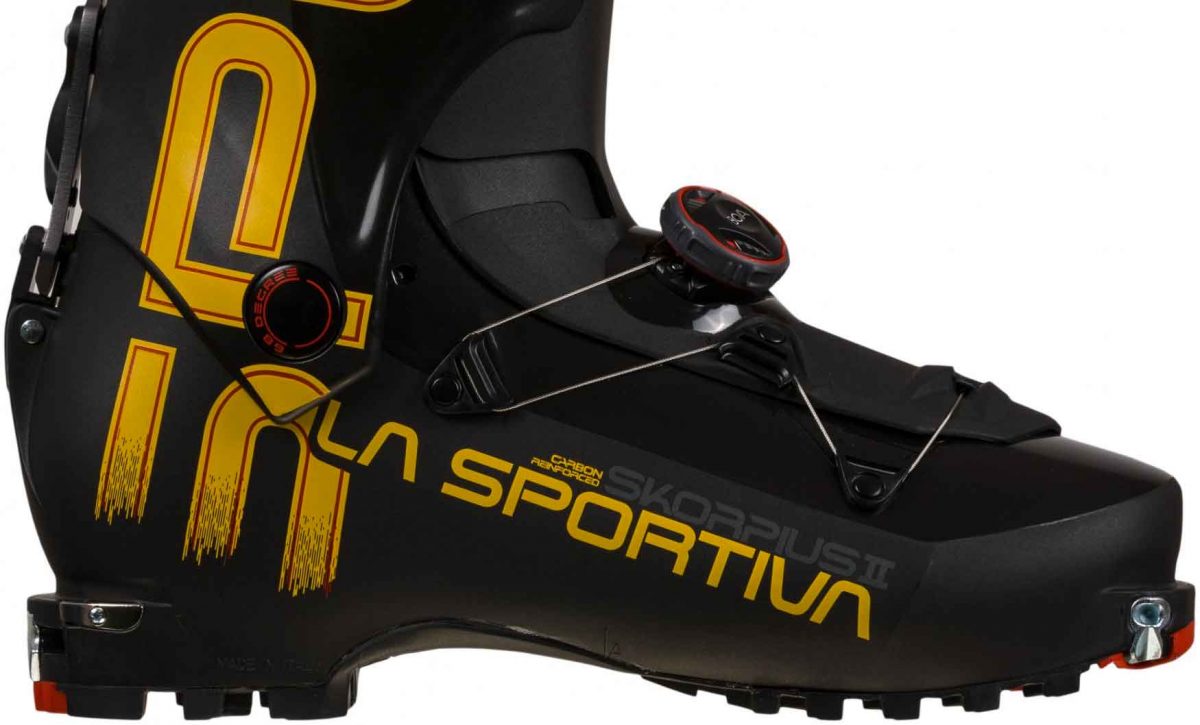A flagship ski boot in the La Sportiva line, the Skorpius CR II is touted to offer performance for demanding ascents and descents. Wild Snow reviewed the boot earlier this winter. In this article, we connect with the Director of R&D at La Sportiva, Matteo Jellici, for a deeper look at the design and tech of the boot.

WildSnow: What market segment of backcountry skier is the Skorpius CR II aimed at?
Matteo Jellici: The Skorpius is aimed at the devout advanced backcountry skier that wants a lighter product for bigger days in the mountains that can still deliver downhill performance for mid-waisted skis. This skier can sacrifice a little stiffness for lighter weight and an amazing ROM for more comfort when ticking lots of vert.
This is the second edition of the Skorpius. How long was the R&D and prototyping process?
Typically a new ski boot takes about 3 years for the full cycle of development, starting with the design brief and all the way to delivery of the product in stores. With a revamp of a boot like the Skorpius CR II we are able to drop a year off of the development cycle.

Matteo Jellici, director of R&D at La Sportiva
What specific changes were made from the original Skorpius?
We added the BOA closure system, redesigned the tongue of the boot, and we added more thickness and comfort to the liner for better downhill performance and comfort.
Can you describe the general prototyping and design process for a boot like the Skorpius?
We have seen a leap in recent years with 3D printing technology. The cycle has sped up dramatically. It all starts with a design brief and a design process. That culminates with a 3D design and then you start mold development. In general, there are about 3-4 iterations of mold design and test cycles.
3D printers now allow the development of a boot that can be fit-tested many times before executing mold development. Mold development is very expensive so you want to be as close to perfect as possible. With 3D printing, we can do some light testing but not full stress testing. Real plastic is needed for that.
When designing ski boots, how many versions do you develop before the final mold?
There are usually about 10-15 various prototypes that are tested before the final molds are produced.

Boa closures added to the updated Skorpius boot
The Skorpius is a boot we often think of as a 1kg+ class ski boot. Can you tell us where it stands in the La Sportiva line?
It is solidly in the middle of our line. We have race-focused products in the Stratos Series and the Racetron. The Skorpius sits directly in the middle and is a lighter-weight ski touring boot that can still drive a mid-waisted ski. The Vega and the Vanguard are on the heavier more downhill-oriented end of the line.
La Sportiva Skorpius CR II Specs
- Weight: 1190g. 1/2 pair (size 26.5)
- Sizes: 23-31.5 +1/2
- Fitting Compatibility: Tech
- Angles: 12° – 14° – 16°
- Range: 68°
- LAST: 101
Several companies have a version of 1kg+ boots that have a carbon cuff. Why does La Sportiva not use a pure carbon cuff in this model?
The carbon-reinforced cuff of the Skorpius is very similar in stiffness to comparable boots from other companies. The Solar and Stellar are essentially the same boot with a plastic cuff.
Thanks for the details, Matteo! We’ll see you out there on the snow.
–This interview was sponsored by La Sportiva. Learn more about the La Sportiva Skorpius CR II at the link.
While most of the WildSnow backcountry skiing blog posts are best attributed to a single author, some work well as done by the group.
